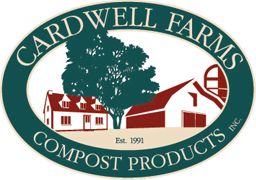Tracking Tools
CARDWELL Farms, located near Sussex, New Brunswick, Canada, in the “Dairy Center of the Maritimes,” began as a landscaping company in 1991. Owner Jim Cunningham needed topsoil for a project, and wanted an alternative to mined topsoil. “As it turned out, if I wanted an alternative, I had to make it myself, so I started a composting operation,” recalls Cunningham. “There was a large hog farmer nearby that had odor problems due to the manure, so I started with that feedstock. And being in the middle of a dairy area, cow manure was plentiful. And bark was available from the forestry industry.”
Initially, composting was done to support his landscaping business, but by the mid-1990s, Cunningham was getting requests for compost from his customers, competitors and others. “By 1996, composting represented about half of my business,” he says. “The amount of material I was processing was getting to be substantial. So I made a decision to go into composting full time. One day, when making a call to a garden products company in Connecticut that was selling a used grinder, I was put on hold, and had to listen to their advertising message about their mulch products. When the owner came on, I asked him if he ever bought compost for his business. He said, ‘as a matter of fact, we were just talking about that this morning.’ I ended up selling them 100 tractor-trailer loads!”
Today, Cardwell Farms produces approximately 65,000 tons of compost and soil amendments annually, which are marketed in eastern Canada and the northeastern United States. Feedstocks include various manures, residuals from seafood processing and aquaculture operations, and forestry by-products. Some materials are composted by themselves (e.g., sheep manure, marine waste) to produce specialty products. The scale of the composting operation has grown to 30 acres (from a half-acre in the beginning). Materials are processed in windrows turned with an excavator and several bucket loaders.
“When we were just receiving small quantities of inputs and sales were smaller, I could manage operations almost out of my head,” says Cunningham. “That was fine for me, but if I wanted to put others in charge of operations, I needed specific recipes and structure.” He turned to Joe Aschl of Aschl Management Systems, who develops software programs for managing all aspects of a composting facility. “I told Joe I needed to keep track of the quantities and qualities of inputs, the value of each input and to develop recipes,” he adds. “When I sell something to customers and they have success with the product, I want to be able to keep making the same product time and time again.” Other parameters tracked via the software are sources of the materials, who hauls them, where they are stored on the property, what was used in the recipe and where the batch is put on the pad for composting. That batch is tracked through to product storage, blending and bagging (with individual bags marked with the lot it came from).
Equally important to this process is being able to accurately predict how much product Cardwell Farms will have available for sale. “As our data base has grown, we know what the shrinkage is for various products,” he explains. “If we want 10,000 cubic yards of a certain product, we know we need to put ‘x’ amount into composting in order to meet our sales projection. And we know exactly what each unit of that product costs. This is valuable information for managing production costs, as well as product quality.” Despite this accuracy, Cunningham says there are still variables that they can’t account for exactly, such as moisture content and type of carbon received. “We can control the impact of the weather on our production, such as flattening piles to absorb rain and peaking the piles so it runs off,” he notes. “With carbon sources, the fibers will vary depending on the time of the year and how they are ground. Basically, the software management system keeps us in the proper circle of the bull’s eye!” — Nora Goldstein
- Posted by siteservice
- On February 23, 2012
- 0 Comment
